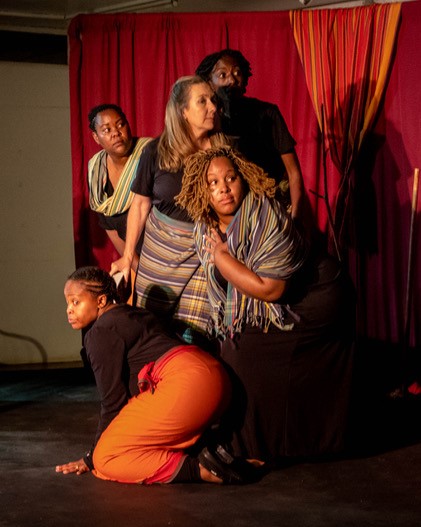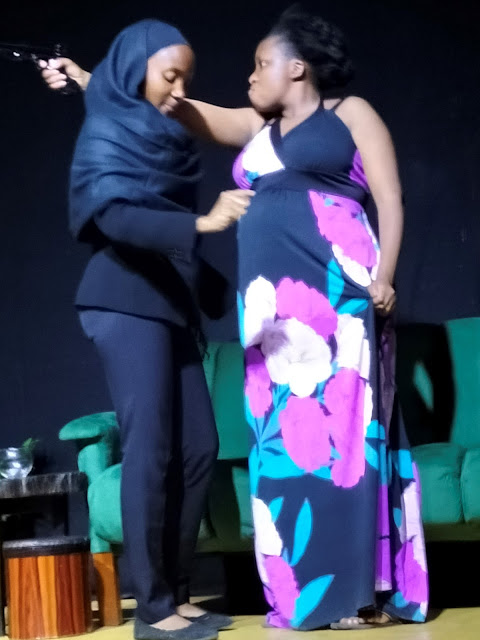By Margaretta wa Gacheru (posted February 26, 2022)
‘Virtual Reality’, the play scripted and directed by Derrick Waswa and produced by Dorion Production Ltd., is not about VR, the technology that creates illusory experiences that enable people to feel as if they are in the Himalayas while they are just sitting on their living room sofa.VR is an
incredible technology which can give one a 360-degree perspective on just about
any place on or off the planet. But in the case of Waswa’s ‘Virtual Reality’,
the term has a more literal and down-to-earth meaning.
It’s still
about some people seeing and believing illusions rather than what most people
call reality. Take the case of motherhood. Tiana (Arara Awuor) looks like she
is a mother of several daughters, including Camilla (Claire Wahome). But her
behavior is anything but motherly, in the sense of being selfless and loving,
especially towards her daughter.
Tiana
doesn’t display a single one of those qualities. For a moment, after hearing Camilla
has been raped by her social media manager, Calistos (Keith Maina), she almost
considers going to the police to report her daughter’s experience and exposing
her business partner. But then, he appeals to her vanity, a factor that plays a
big role in Tiana’s life. He also tells her he will destroy all her YouTube
videos, reveal all her intimate emails, and cancel all her precious social
media contacts. She’s currently using those contacts to build bridges into the
heart of cable TV. He ultimately succeeds in convincing her it’s in her
interest not to save her daughter even though she contracts AIDS from the guy.
Virtual Reality
in Waswa’s play takes on many shapes and constructs, it would seem. That
includes the reality and virtual reality of marriage, including family. Another
virtual reality to be tackled by Waswa is monogamy, which has been attacked by
African traditionalists from the first days that Christian missionaries
introduced it as part of the ‘Good News’.
In any case,
the law is meant to give us a clear sense of social civility. It’s meant to
give us a line that is clearly drawn between good and evil, black and white,
right and wrong. As it turns out, there is nothing that concise in Waswa’s
world.
For
instance, baby-making is something that normally happens between a man and a
woman who have intimate relations. But now, medical science has invented new
ways to make babies. Now you can do it ‘in vitro’, by sticking an embryo in a
test tube and then mixing in a bit of sperm. After that, if conditions are
right, you can find the egg getting fertilized by the sperm. Then, the magical
mix can be transferred into any available womb. And finally, Presto! After nine
months, a baby is virtually born!!
Waswa
illustrates the hazards of making virtual babies by ‘in vitro’ means. First,
you have to find a virtual or surrogate mother like Sasha (Mithcele Atieno) to
make her womb available for the nine-month process for the plan to work. In the
case of Judge Joyce and Philip who try the ‘in vitro’ method of baby-making,
they are shocked at the outcome. The baby is born with virtually no genitalia,
neither boy’s nor girl’s. For Joyce, it’s as if this is not a real baby, but to
Philip, the baby is acceptable as long as he can be raised as a boy.
Given I didn’t
see the tail-end of the show, I can only assume Waswa had intended to send a message.
And that was that our society has gone crazy with virtual reality, so much so
that it’s making people hypocrites and fraudsters from morning till night. The
plainest illustration of that is Tiana who is essentially trying to create her
own ‘reality show’ comparable to the one that made the Kardashians rich and
famous. But there is nothing genuine or spontaneous or even real about what she
and her manager are filming. Perhaps when I missed the last portion of the
play, I missed the arrival of characters who had some integrity, honesty, and
simple goodness. Otherwise, they were virtually absent from ‘Virtual Reality’.

























